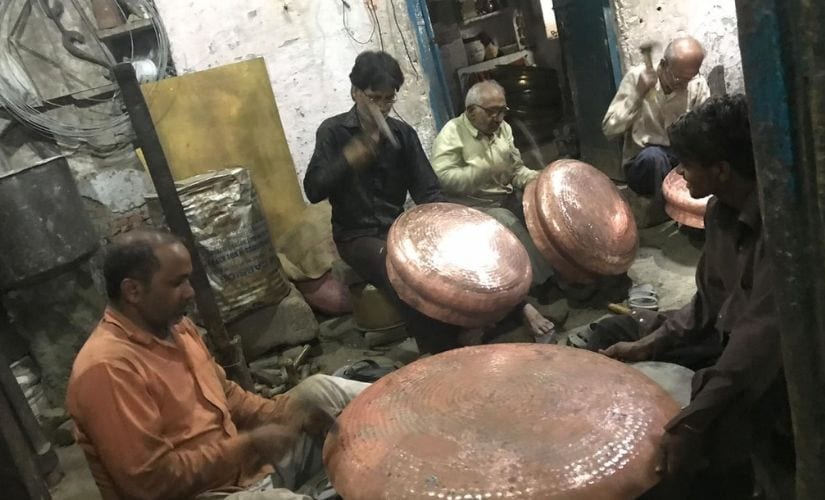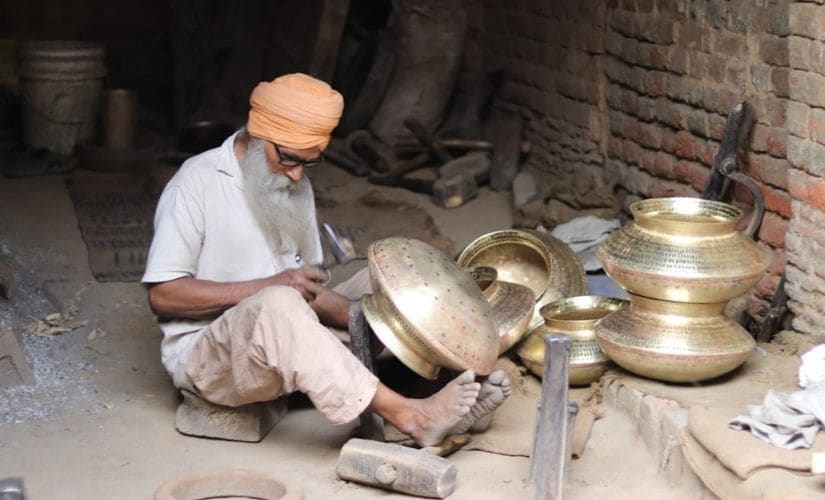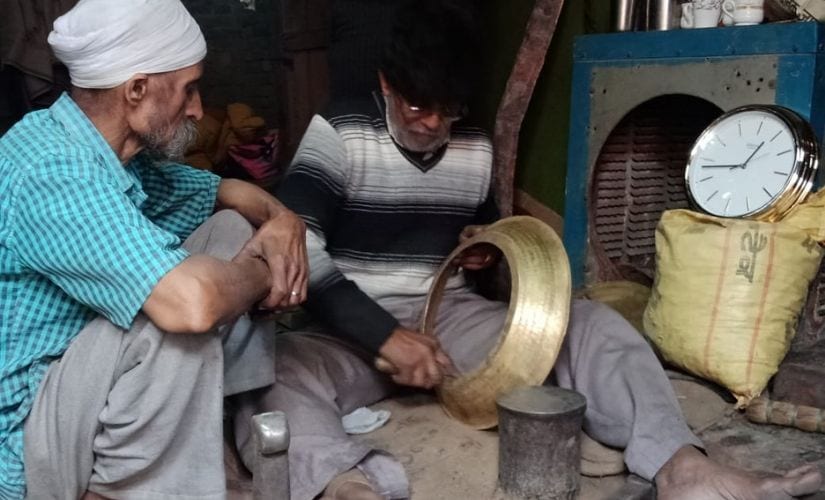Long before singer Kanika Kapoor crooned “Yeh duniya pital di”, actress Simmi Grewal sang “Pital ki mori gagri Dilli se mol mangaai re…” in Khwaja Ahmad Abbas’s film Do Boond Paani, all the way back in 1971. Numerous folk songs have been composed with pital (brass) and tamba (copper) as metaphors, but times they are a changin’, as the two metals have slowly gone out of use. Kalaiwalas, or men re-tinning brass and copper wares, have disappeared with the gradual ascendance of stainless steel in our homes, and have taken the thatheras —makers and sellers of brass and copper utensils — with them. Today’s youth may barely have heard the names of these craftsmen, despite the fact that they were integral parts of the Indian household even two generations ago. However, ironically, a group of student-volunteers from Delhi’s Shri Ram College of Commerce are rallying to restore the priceless skills of the thatheras for current and future generations. Their efforts, initiated in 2018, are a part of Enactus, a student-run international non-profit organisation that handles a part of Project Virasat’s Punjab Thathera Art Legacy (P-TAL). Jandiala Guru — not just another village When the Sikh Empire was at its peak, Maharaja Ranjit Singh established Jandiala Guru — a small village, about 20 kilometres from Amritsar — as a crafts hub, by bringing in the best artisans from across the country. Even though thatheras worked all over India, the metalsmiths of this town had exceptional skills, as a result of which their unique craft was the first in the category to make it to the prestigious UNESCO Representative List of Intangible Cultural Heritage of Humanity from India, in 2014. [caption id=“attachment_6984701” align=“alignnone” width=“825”]  Thatheras at work[/caption] Following the United Nations’ lead, the group of students at SRCC have been working tirelessly in various social sectors — like health and sanitation, handicrafts, and agriculture — in collaboration with the Ministry of Tourism in Punjab, and the district administration of Amritsar, to achieve their goals through Enactus. Craftsmen turned labourers It took the volunteers prolonged research and reorganisation of the community to help them revive their craft. “When we first arrived at Jandiala Guru, we discovered that there was a lack of ownership among the thatheras. The number of families involved in this craft had reduced from 500 to just 30. We also figured that exploitation by the Kasariyas — middlemen that made untimely and inadequate payments — was a common exploitative trait faced by most community members. They also had internal conflicts amongst themselves, as the opportunities were very limited. We, therefore, went on to organise the community of thatheras into a self-help group, a legalised entity now known as P-TAL. P-TAL is working directly with the thatheras, improving and managing the supply chain, linking them to markets and managing their finances," Jayana Jain of Enactus says. P-TAL’s journey started with only one thathera — Manoharlal — who was the only one willing to invest a small amount in their enterprise. Today, there are 14 more on board. “We are hoping for the numbers to keep increasing," Jain says. After conducting comprehensive surveys of the 14 thathera families who have collaborated with P-TAL, the team of volunteers realised how multiple issues have reduced the craftsmen to mere labourers, leading to a significant decline in the number of metalsmiths. Reviving the thathera legacy P-TAL ensured that the primary process of production remained unchanged, in order to holistically preserve the thathera’s heritage. “But we’ve supplemented the process to provide best possible finishing quality, and prevent tarnishing. For this, we introduced electrophoretically lacquering – a cutting edge technology that prevents copper and brass from blackening over time – instead of the tin coating inside the brass utensils that they used to do, known as kalai," Jain says. [caption id=“attachment_6984711” align=“alignnone” width=“825”]  Tthatheras: a community of brass and copper ware makers in India[/caption] While Dolly Singh, a retired art teacher from Amritsar, helped the Enactus team with her experience and association with the thatheras, Kirti Goel, a graduate from Pearl Academy in Fashion Designing, came up with 65 new designs for the craftsmen and invested in the project. Both of them keep the community motivated to sustain their craft. Enriched by support from the local community, the team of volunteers is helping the thatheras reach new platforms, like craft and décor retail stores, premium e-commerce websites and exhibitions. They help the community receive online orders through the P-TAL website as well. So far, P-TAL has exhibited their products at the Indian International Trade Fair in Delhi, Jaipur Literature Festival, Vanity Fair in Chandigarh, and the Italian and Austrian embassies. The organisation retails their products at Gobindgarh Fort in Amritsar, and works in collaboration with some premium stores in Delhi, like Gully 39 at Khan Market, Tatsat in Hauz Khas, and Phulakri Emporium in Connaught Place. P-TAL has further collaborated with JJ Home Decor in Gurugram, Tapri Retail in Jaipur, and Toran in Chennai. Their products are also on display at the Mumbai International Airport and Amritsar Airport. “All the revenue that is collected after selling the copper and brass utensils is reinvested to purchase raw material, after distributing a fair share of it to the thatheras," says Kirti Goel. “They now receive close to Rs 9,000 per month, as compared to a few years ago when they used to get a meagre Rs 2,500. More than this, what really brings a deep sense of satisfaction is the stories of young boys like Gaurav, who came back to his craft after working for five years in a thread factory in Ludhiana. He still couldn’t sustain himself. This is a milestone for us. As we ventured and he saw the profits coming, he returned to his craft — the legacy which was carried by his forefathers,” she adds, proudly. [caption id=“attachment_6984751” align=“alignnone” width=“825”]  In the process of making a brass utensil[/caption] How the thatheras were assured a promising future In 2014, Yamini Mubbaayi, a social researcher who had worked extensively on the thatheras and their craft, submitted her study to the UNESCO, following which the tourism and culture minister of Punjab, Navjot Singh Sidhu, launched P-TAL in 2017. Soon after, the state government not only went on to announce a grant of Rs 10 lakh for the development of the project, but also sanctioned Rs 3 crore for the betterment of Jandiala Guru village, thereby restoring faith in the invaluable power of art uplifting lives.
The thatheras are a community of artisans making and selling brass and copper ware in India, who’ve gradually faded out, as stainless steel took over our lives. In order to save the craft of the thatheras, a group of students from Delhi’s Shri Ram College of Commerce have volunteered to help the community.
Advertisement
End of Article


)
)
)
)
)
)
)
)
)



